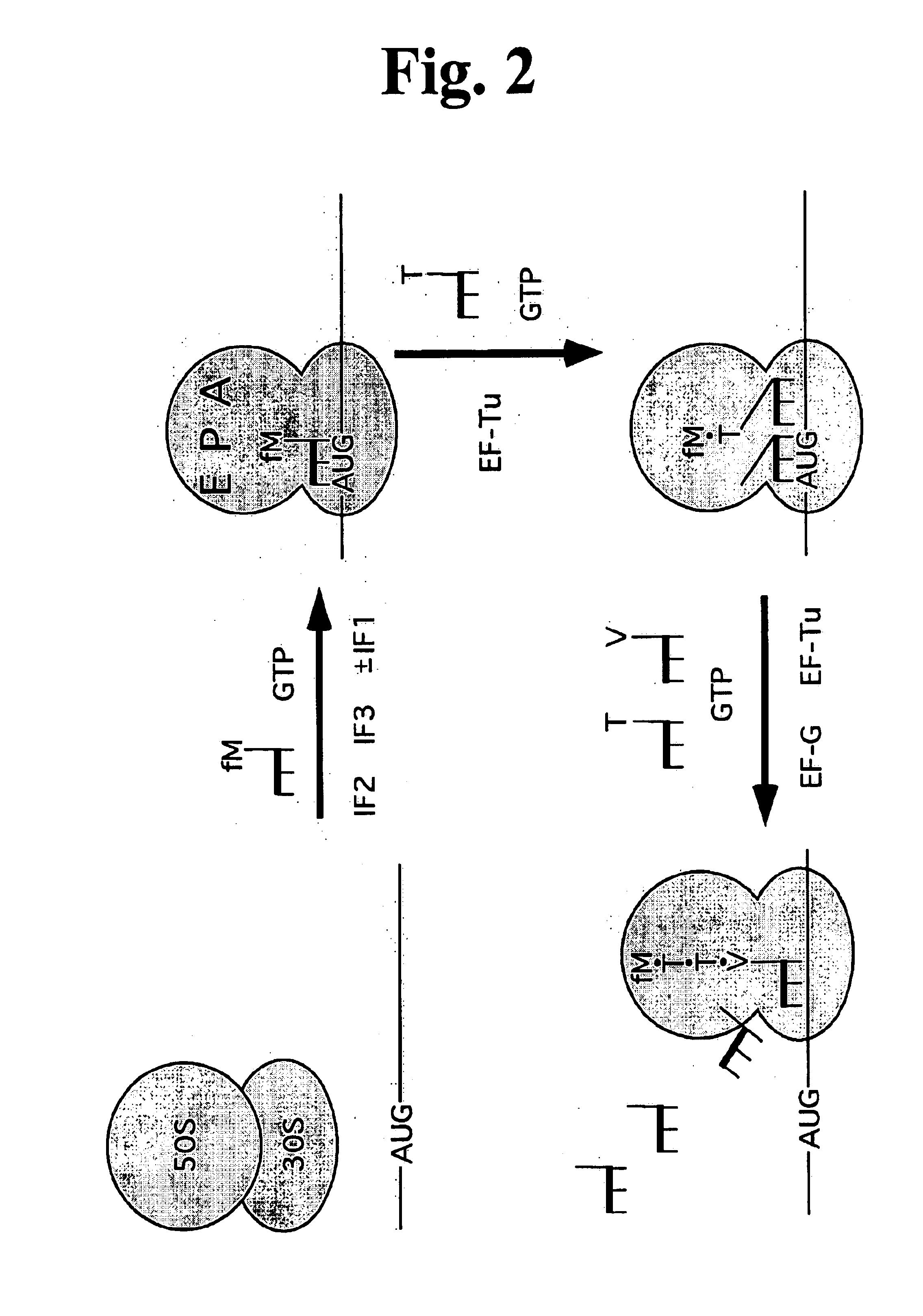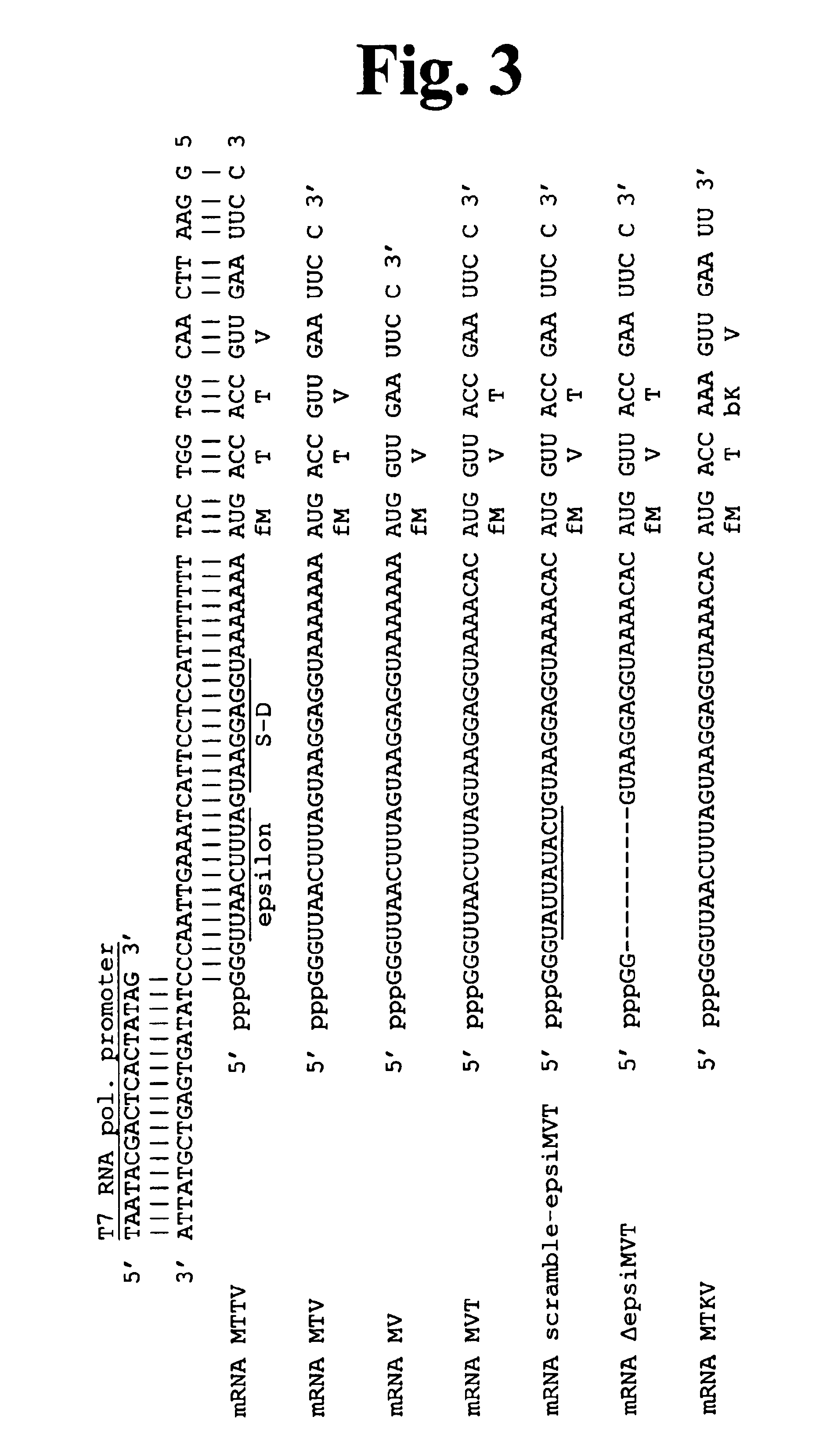While non-biosynthetic libraries have the
advantage of being unrestricted to biological monomers (such as natural amino acids and nucleotides) and their derivatives, they have the
disadvantage of being limited in the number of molecules that may be screened within several weeks: usually 105 to 108 at most, which is too few molecules for favoring the identification of high affinity ligands for a target of interest (Roberts (1999) Curr. Op. Chem. Biol.
The prior art “natural” (L-)
peptide library techniques, however, suffer from a number of disadvantages.
First, the libraries, which consist almost entirely of chiral monomers (amino acids) lack the enantiomers of the chiral monomers.
L-
peptide libraries also lack a number of common
organic chemistry functional groups which may be helpful for forming non-covalent or covalent complexes with targets (e.g.
alkene,
alkyl urea,
alkyl halide, and
ketone), and lack the enormous additional shape diversity achievable with “unnatural” amino acids (either previously synthesized or theoretical).
Moreover, as therapeutic agents, peptides with natural L-amino acids are often less preferable than their unnatural enantiomers (D-peptides) or analogs because L-peptides can be limited in use by poor pharmacokinetic profiles due to
in vivo processing.
Furthermore, pharmaceutical peptides can elicit strong immunogenic responses in patients, further contributing to their rapid clearance and also causing inflammatory reactions that may be toxic.
In doing so, the resulting
peptidomimetic can suffer from decreased bioactivity through loss of certain binding contacts between the natural
peptide backbone and target
receptor, as well as changes in the steric space relative to the peptide due to alteration in dihedral angles and the like.
Another problem is that almost all L-peptides do not cross biological membranes readily because of their hydrophilicity.
Unfortunately, chemically synthesized (non-biosynthetic)
peptidomimetic libraries, such as D-peptide libraries (Lam et al., supra; Dooley et al., supra) suffer the limitation of
library size discussed above, and methodological tricks to overcome the size limit of
peptidomimetic libraries, such as mirror-image phage or
ribosome display (Schumacher et al.
However, the method is inefficient or impractical for longer products because of inefficient
coupling steps, purification problems, and folding difficulties.
There are also synthetic restrictions because of the need for compatible protecting groups for all of the reactive side chains in a desired product.
Furthermore, synthetic peptidomimetics cannot be genetically encoded for reiterative selection, amplification, and
mutation (evolution), limiting the complexity of synthetic peptidomimetic libraries to about 108 molecules, too few for optimal
drug discovery.
However, synthesis may be inefficient if the
gene product is toxic, and there may be difficult purification and refolding problems, particularly if the
protein is expressed in
inclusion bodies.
Most importantly, the method suffers from the inability to incorporate multiple unnatural amino acids selectively or control the post-translation modification process (e.g.
protease-catalysed
processing or degradation).
However, the incorporation of an unnatural
amino acid by this approach usually suffers from much lower yields than
in vivo systems because it relies on inherently inefficient
suppressor tRNAs competing with termination factors.
Many attempts to incorporate unnatural amino acids selectively at sense codons in a generalizable manner have also failed.
While a low selectivity of
amino acid analog incorporation is sufficient for certain applications (Rothschild et al., U.S. Pat. No. 5,643,722) it is clearly incompatible with many applications such as that requiring the amplification and characterization of genetically encoded specific peptidomimetic sequences.
However, both of these methods are not generalizable in the manner necessary for the incorporation of many different unnatural amino acids into a single peptidomimetic.
Unfortunately, the minimal requirements for mRNA-dependent polypeptide synthesis have been difficult to define because of the large number of macromolecules involved.
Reconstitution of translation from purified components has been achieved for E. coli, but the number of translation factors required remains controversial.
The absence of these factors resulted in innefficient
processivity.
This is problematic because
contamination with EF-P, W, W2 and / or rescue likely implies
contamination with more abundant proteins, such as aminoacyl-tRNA synthetases and termination factors, that could cause unwanted reactions.
The ability to synthesize peptides or proteins from a pure
translation system without added EF-P, W (sometimes called W2) and rescue is desirable, if possible, because these proteins are not well understood in terms of function, resulting in difficulty in assaying their activities and therefore following the purification of
active protein.
Furthermore, there is controversy with respect to the actual size of W (or W2) and whether W and W2 represent derivatives of the same proteins, and the
gene for rescue is yet to be cloned.
 Login to View More
Login to View More 


